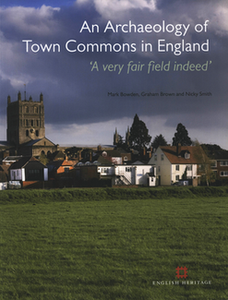English Heritage Archaeological Monographs
English Heritage, 2014. https://doi.org/10.5284/1028203. How to cite using this DOI
Data copyright © English Heritage unless otherwise stated
This work is licensed under the ADS Terms of Use and Access.
Primary contact
Historic England
The Engine House
Firefly Avenue
Swindon
SN2 2EH
Resource identifiers
- ADS Collection: 1416
- DOI:https://doi.org/10.5284/1028203
- How to cite using this DOI
An Archaeology of Town Commons in England 'A very fair field indeed'
Bowden, M., Smith, N., Brown, G.
English Heritage (2009)
Abstract:

This is the first published overview of the archaeology of urban common land. By recognising that urban common land represents a valid historical entity, this book contributes towards successful informed conservation. It contains a variety of interesting and illuminating illustrations, including contemporary and archive photographs. Historically, towns in England were provided with common lands for grazing the draft animals of townspeople engaged in trade and for the pasturing of farm animals in an economy where the rural and the urban were inextricably mixed. The commons yielded wood, minerals, fruits and wild animals to the town's inhabitants and also developed as places of recreation and entertainment, as extensions of domestic and industrial space, and as an arena for military, religious and political activities. However, town commons have been largely disregarded by historians and archaeologists; the few remaining urban commons are under threat and are not adequately protected, despite recognition of their wildlife and recreational value. In 2002, English Heritage embarked upon a project to study town commons in England, to match its existing initiatives in other aspects of the urban scene. The aim was to investigate, through a representative sample, the archaeological content and Historic Environment value of urban commons in England and to prompt appropriate conservation strategies for them. The resulting book is the first overview of the archaeology of town commons - a rich resource because of the relatively benign traditional land-use of commons, which preserves the physical evidence of past activities, including prehistoric and Roman remains as well as traces of common use itself. The recognition of town commons as a valid historical entity and a valued part of the modern urban environment is an important first step towards successful informed conservation. An important consideration for the future is maintaining the character of town commons as a different sort of urban open space, distinct from parks and public gardens.
Download monograph
| An Archaeology of Town Commons in England 'A very fair field indeed', Bowden, M.|Smith, N.|Brown, G., English Heritage (2009), ISBN: 9781848021761 | 21 Mb |





